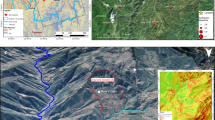Abstract
The Taosi site in Xiangfen County, Shanxi Province, may be the capital of the King Yao. Archeologists recently discovered a large semi-circular stamped-earth platform, II FJT1, which has a clear and definite pounded-earth central core together with a curved wall perforated by twelve gaps. The platform is said to be an ancient observatory used to determine the seasons by watching the sunrise. Each feature of II FJT1 was precisely measured and the data are reproduced in this paper. An astronomical analysis of slots E2 and E12 was carried out using the azimuths of the slots’ centerlines and the vertical angle of the mountain ridge opposite, above which the sun rises. The results show that at present the sun is close to the two slots but does not exactly enter them at summer and winter solstice sunrise. Using 14C analysis archeologists dated the site to about 2100 BC. Because of the secular change in the obliquity of the ecliptic, at that date on the summer solstice the half-risen sun would have appeared inside slot E12 just to the right of the centerline, and on the winter solstice the sun would have been exactly on the centerline of slot E2. This result provides compelling proof that II FJT1 is an ancient observatory.
Similar content being viewed by others
References
Institute of Archaeology of the Chinese Academy of Social Sciences, Shanxi Provincial Institute of Archaeology, Cultural Relics Bureau of Linfen City. 2003 Excavation on foundation of large building on the sacred area of Taosi in Xiangfen, Shanxi (in Chinese). Archaeology, 2004, 7: 9–24
He N. A retrospective on excavation of large building II FJT1 of Taosi site. Ancient Civil Rev, 2004, 23: 47–58
Institute of Archaeology of the Chinese Academy of Social Sciences. Report of simulated observation at the foundation II JFT1, Taosi (in Chinese). Ancient Civil Rev, 2006, 29: 3–14
Wu J B, He N. A preliminary study on the astronomical date of the large building II JFT1, Taosi (in Chinese). Bull Ancient Civil Center, CASS, 2004, 8: 50–55
Institute of Archaeology of the Chinese Academy of Social Sciences, Shanxi Provincial Institute of Archaeology, Cultural Relics Bureau of Linfen City. 2004-2005 progress of excavation on Taosi site, Xiangfen, Shanxi (in Chinese). Bull Ancient Civil Center, CASS, 2005, 10: 58–64
Jiang X Y, Chen X Z, Yi S T, et al. Discussions on the ruined peculiar structure on the Taosi-site and its function as an observatory (in Chinese). Archaeology, 2006, 11: 81–94
Liu C Y. Two problems on the calendar of early Zhou dynasty (in Chinese). Public Shaanxi Obs, 2001, 2: 160–164
Seidelmann P K. Explanatory Supplement to the Astronomical Almanac. Mill Valley: University Science Books, 1992. 144
Laskar J. Secular terms of classical planetary theories using the results of general theory. Astron Astrophys, 1986, 157: 59–72
Author information
Authors and Affiliations
Corresponding author
Rights and permissions
About this article
Cite this article
Wu, J., Chen, M. & Liu, C. Astronomical function and date of the Taosi observatory. Sci. China Ser. G-Phys. Mech. Astron. 52, 151–158 (2009). https://doi.org/10.1007/s11433-009-0017-1
Received:
Accepted:
Published:
Issue Date:
DOI: https://doi.org/10.1007/s11433-009-0017-1




